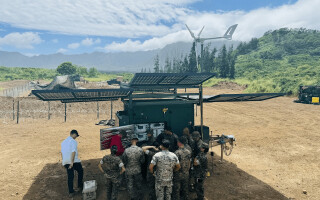Mobile energy: powering the future battlefield
StoryNovember 26, 2024

The modern military’s power needs are growing more complex with each passing year. The rapidly changing dynamics of warfare, driven by technological advancements and evolving operational strategies, are reshaping how power is used, distributed, and sustained on the battlefield. This shift, coupled with federal mandates to reduce reliance on fossil fuels, is placing increased pressure on military leaders to rethink energy and power systems. The challenge is no longer just about generating power; it’s about how to deliver it efficiently, flexibly, and rapidly to dispersed units in the field.
Today’s battlefield requires power for an abundance of new technology and equipment, and this shift will require a combination of grid power, fuel-based generators, and battery-electric energy. We’re not just talking about radios or computers anymore; today’s battlefields involve electric vehicles, drones, broadband connectivity, and even electric vertical takeoff and landing (eVTOL) aircraft, all of which need power, and lots of it. Throw EV [electric vehicle] mandates for nontactical vehicles into the mix and the challenge becomes even more complex, driving greater need for electricity and battery storage to support both installation and operational energy.
Dispersed battlefields require flexible power
As the battlefield continues to evolve, the lines between installation and operational environments are blurring. The modern battlefield is becoming more lethal, and survivability depends on units operating in a more decentralized manner to avoid detection. While dispersing units and equipment across vast areas can improve operational effectiveness, it creates challenges to the supply chain and causes a new problem: How do you get a reliable supply of energy, in the right form, to these units to keep them functioning?
Imagine a scenario where an electric drone or surveillance system needs to be recharged miles from a forward-operating base but the installation and fueling to prop up a new microgrid is strategically disadvantageous, either by taking too long to deploy or drawing too much attention to the area. What is the best solution? How will units deploy, operate, reach, recharge, and safeguard electric power assets in the field?
In this new operational landscape, speed, resiliency, and agility will be key. When military units become more mobile and operations more dispersed, energy systems must be able to keep up. The advantage of tactical microgrids is of interest to the military and will require complimentary technologies that can both support these grids and move power from them to other assets in the field.
That’s where mobile energy is both the problem and the solution. Developing mobile power sources that can move seamlessly with units as they deploy, operate, and reposition is the kind of energy flexibility that will be critical in modern warfare, where all technological advantages can be utilized, and the ability to adapt quickly to changing conditions can be the difference between mission success and failure.
The future of military power is mobile
As the military looks to the future, energy resilience will be a critical focus. The ability to generate, store, and distribute power across dispersed and mobile units will be crucial to maintaining tactical superiority. The integration of battery-electric solutions, tactical microgrids, and mobile power systems will play a vital role in ensuring that the military’s energy infrastructure is as agile and adaptable as its operational strategies.
Knowing all of this, military personnel must consider the following when evaluating mobile energy solutions:
- Assess mobility and agility needs. Power systems must be quick and easy to deploy, relocate, and adapt to changing battlefield conditions, with rapid setup and takedown capabilities.
- Evaluate power capacity and compatibility. Solutions should handle diverse needs, from AC power for infrastructure to DC fast charging for EVs and aircraft, with flexibility for various voltages and seamless integration with microgrids.
- Provide resilience and redundancy. Mobile power must offer reliability under rugged conditions, with battery storage and bidirectional power capabilities that support both backup and primary distribution roles. Look for solutions with redundant features and robust energy storage to maintain functionality in the face of grid outages, cyberthreats, or physical disruptions.
The future of military power is decentralized, flexible, and increasingly reliant on battery-based technologies that can move as fast as the forces they support.
Bridging the gap between installation and operational energy
Mobile power is definitely on the rise for battlefield use: Large tactical rechargers, hybrid power-generation vehicles, thermophotovoltaic turbines, mobile nuclear power plants, and fuel cells are in use with more under development. One example is the electric Mobile Power Station (MPS) by DANNAR: The MPS is designed to meet the military’s evolving power needs by offering a modular, mobile, and scalable energy solution that is capable of receiving and distributing power. It is being tested to seamlessly hook into a tactical microgrid to recharge or deliver power and then transport that power to where it’s needed most, supporting a wide range of applications in the field.
The MPS can deliver bidirectional power at both military and industrial levels, from 480 three-phase to DC fast charging for electric vehicles, drones, and eVTOL aircraft, and 208 V in development and testing. For installations, the MPS can serve as a reliable backup power source for command centers, field hospitals, or maintenance bays. In the field, it is also a mobile charger capable of recharging vehicles, drones and other electric equipment wherever it is deployed. (Figure 1.)

[Figure 1 | The DANNAR Mobile Power Station can be deployed to receive, store, and deliver electric power to dispersed units in the field or wherever they are.]
Power in the field
Additionally, the MPS participated in a U.S. Department of Defense (DoD) Defense Innovation Unit (DIU) test under which DANNAR deployed multiphase units supporting eVTOL operations at two sites held by the Air Force and vehicle-to-grid/vehicle-to-vehicle resilience evaluation efforts at three more sites operated by the Navy and Marine Corps. eVTOL charging has also been tested by experts at AFWERX where the MPS, carrying a half-megawatt of stored energy, both recharged electric aircraft and also powered ground control computers plus various other power tasks. (Figure 2.)

[Figure 2 | AFWERX and MTSI [Modern Technology Solutions Inc.] evaluated the MPS as mobile power support for electric vertical takeoff and landing (eVTOL) aircraft for military applications.]
The challenge for military decision-makers is to ensure that any energy supply not only meets current needs but is also scalable for future requirements. By integrating versatile, mobile power solutions, the military can ensure that it has the energy resilience needed to operate effectively in any environment.
Gary Dannar is the founder and CEO of DANNAR, which focuses on providing heavy-duty work capabilities with grid-scale auxiliary power. In addition to his years at Ford Motor Company and New Holland, where he drove sales and business development for heavy equipment, he also led product development for The General and the Alamo Group. He also started and acquired businesses including Little Roadside Management and the Kitselman Pure Energy Park.
DANNAR https://www.dannar.us.com/






